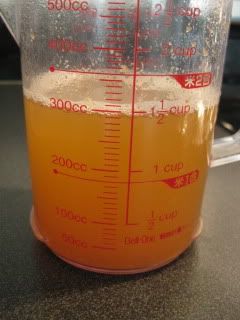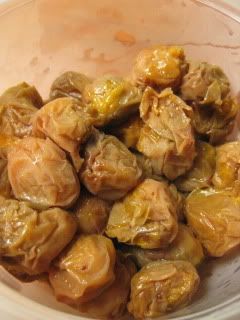Once soy sauce become commonly accessible, the needs for Irizake died down and eventually it
became almost forgotten, except at some traditional Japanese restaurants. But lately, Irizake has been re-discovered
by more home-cooks and is going through a quiet revival trend of its own.
I researched so
many different Irizake recipes (so many variations!) to come up with my final
version, which is really simple and basic. But, it was quite a journey!
Ingredients List:
1 bottle (720 ml)
Junmai Sake
1 piece 2” x 2” dashi kombu (dry kelp)
6-7 small to
medium-size umeboshi (pickled plum)
15g katsuo bushi (shaved dry bonito flakes)

SAKE: Don’t use a “cooking sake” or
alcohol-added kind. Quality
“Junmai” sake is a good choice, but there is no reason to use a very expensive
kind. My bottle was about $10.

Dashi Kombu:
I used “Rishiri Kombu” (from Hokkaido), because it brings cleaner flavor.
UMEBOSHI: Yes, for a high-quality Iri-zake, you want to use high-quality umeboshi. So, I ended up making my own umeboshi! If you use a purchased kind, make sure it has no additives.


Katsuo
Bushi: Premium “Honkare Bushi” from Kagoshima. Bonito was shaved right before it was used.
Procedure:

To start,
soak Dashi Kombu in Junmai Sake for 3-4 hours. Remove. (No
heating is necessary, because kombu is used for bringing just a subtle flavor
to the sake.)

Add Umeboshi to the sake and bring to simmer.
Simmer for 5-6 minutes.


Add Katsuo
Bushi and continue to simmer for 15-20 minutes until the sake is reduced by
half. Remove from heat and let it
rest for 5 minutes.

Strain the
sake through a fine-mesh strainer.
This is your Irizake.




The
beautiful almost flowery aroma of sake and katsuo bushi filled up the entire
kitchen and it was just amazing.
As soon as I tasted my first homemade Iri-zake, I was so blown
away. It was nothing like I’d ever
tasted before…I just couldn’t believe how amazing it tasted! I wanted to drink the whole thing right
away! This Irizake will become an
essential ingredient in Naoko’s kitchen from now on.


My first Irizake
dish was with freshly made rice with my double-lid donabe rice cooker, “Kamado-san”. I topped the rice
with a mixture of super-thin katsuo-bushi (shaved bonito) and nori (roasted
seaweed) and simply drizzled some Irizake. Righteous!!! I
wish everybody who read this could taste it. To serve with the Irizake seasoned rice, I made simple tofu and wakame seaweed miso soup with my homemade 2-year-aged miso in the beautiful soup & stew donabe, "Miso-shiru Nabe". Humble and perfectly gourmet moment.
Happy donabe
life.

